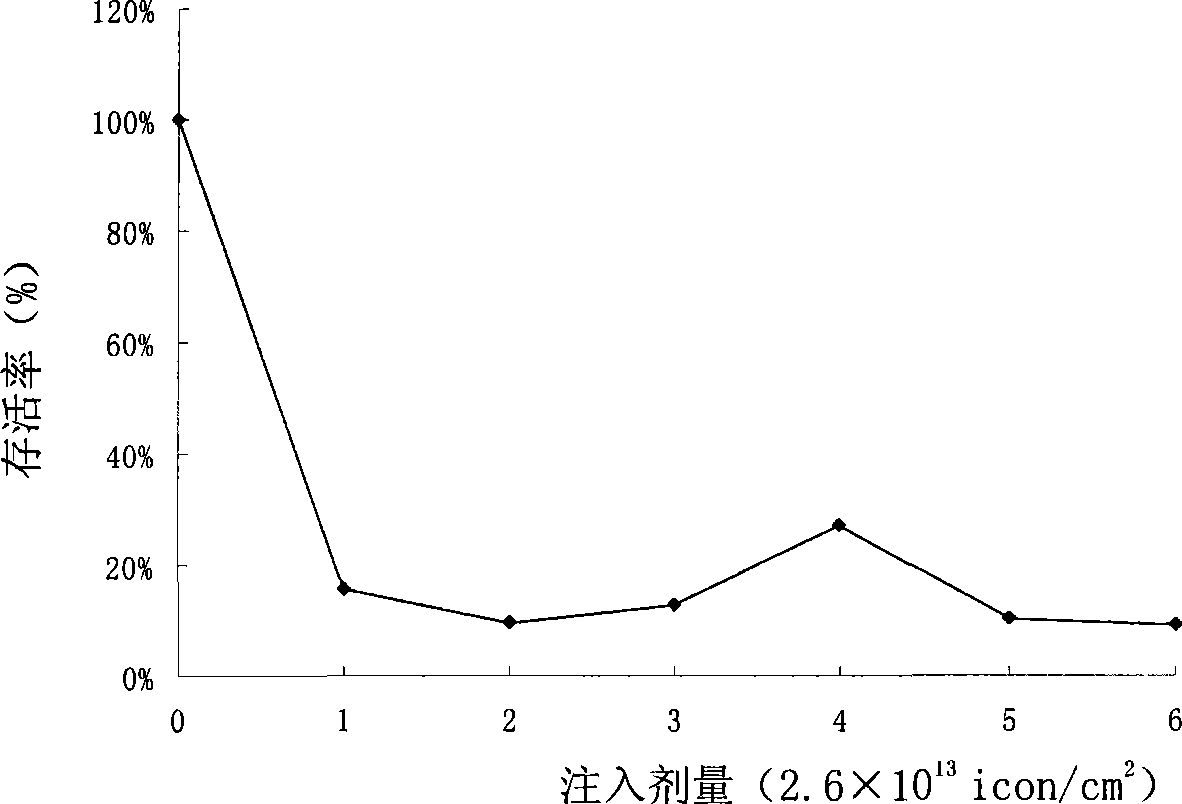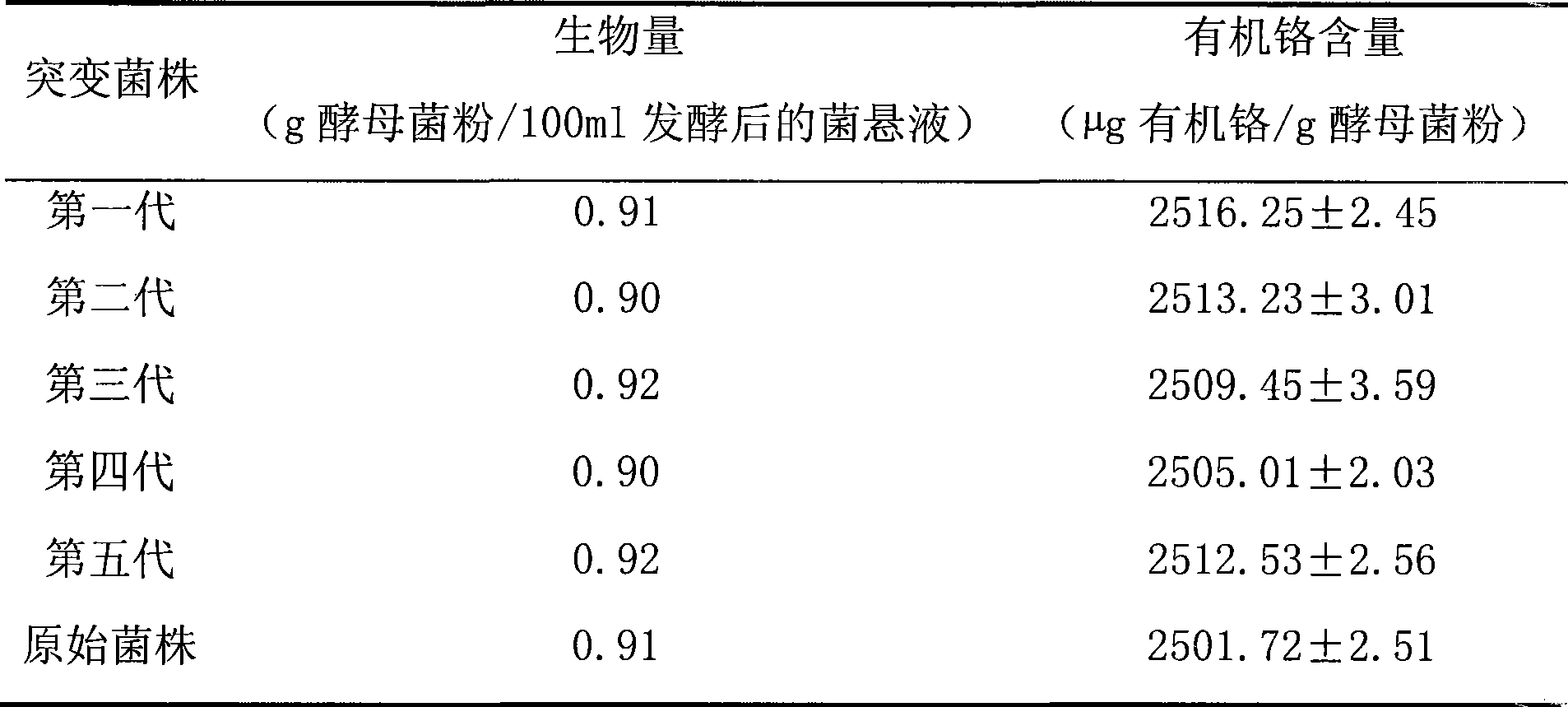Method for producing biological organic chromium and special bacterial strain thereof
A technology of organic chromium and chromium ions, which is applied in the field of producing biological organic chromium, can solve problems such as low cost, and achieve the effects of low cost, high output and simple test conditions.
- Summary
- Abstract
- Description
- Claims
- Application Information
AI Technical Summary
Problems solved by technology
Method used
Image
Examples
Embodiment 1
[0020] Example 1, the acquisition and identification of Saccharomyces cerevisiae YSI-3.7
[0021] 1. The preparation of culture medium
[0022] Seed medium: 10g yeast extract powder, 20g peptone, 20g glucose, 1000ml distilled water, pH5.6.
[0023] Fermentation medium: chromium trichloride 1.56×10 -3 mol / L, yeast extract powder 10 g / L, peptone 20 g / L, glucose 20 g / L, solvent is water; pH is 5.6.
[0024] 2. Obtaining of strain YSI-3.7
[0025] 1. Obtainment of strain Y-3
[0026] Strain Y-3 was isolated from the yeast mud provided by Beijing Brewery. The specific steps are as follows:
[0027] (1) Sampling: Aseptically sample about 1 gram from fresh beer yeast mud, put it into sterilized physiological saline, and mix well.
[0028] (2) Dilution: Repeatedly dilute the sample solution with sterile saline to 10 -6 .
[0029] (3) Invert the plate: Take 1 ml of the dilution from step (2) and add it to a petri dish, pour the melted YEPD solid medium at 45°C, shake slowly to m...
Embodiment 2
[0073] Embodiment 2, utilize Saccharomyces cerevisiae YSI-3.7 to produce organic chromium
[0074] 1. The preparation of culture medium
[0075] Seed medium: 10g yeast extract powder, 20g peptone, 20g glucose, 1000ml distilled water, pH5.6.
[0076] Fermentation medium: chromium trichloride 1.13×10 -3 mol / L, yeast extract powder 5 g / L, peptone 15 g / L, glucose 15 g / L, solvent is water; the pH of the medium is 5.0.
[0077] 2. Production of organic chromium
[0078] Pick 1 ring of activated Saccharomyces cerevisiae YSI-3.7 with an inoculation loop and place it in the seed medium, and cultivate it on a shaker at 28°C, 200r / m, and 12mm radius of rotation for 15h to obtain the seed liquid; T) Inoculate the seed solution into the fermentation medium, and ferment for 25 hours on a shaker at 25°C, 150r / m, and 12mm radius of rotation. The experiment was repeated three times, and the results were mean ± standard deviation.
[0079] After the fermentation was finished, the biomass a...
Embodiment 3
[0080] Embodiment 3, utilize Saccharomyces cerevisiae YSI-3.7 to produce organic chromium
[0081] 1. The preparation of culture medium
[0082] Seed medium: 10g yeast extract powder, 20g peptone, 20g glucose, 1000ml distilled water, pH5.6.
[0083] Fermentation medium: chromium trichloride 1.88×10 -3 mol / liter, 15 grams / liter of yeast extract powder, 25 grams / liter of peptone, 25 grams / liter of glucose, and the solvent is water; the pH of the medium is 6.0.
[0084] 2. Production of organic chromium
[0085] Pick 1 ring of activated Saccharomyces cerevisiae YSI-3.7 with an inoculation loop and place it in the seed medium, and cultivate it on a shaker at 28°C, 200r / m, and 12mm radius of rotation for 15h to obtain the seed liquid; T) Inoculate the seed solution into the fermentation medium, and ferment for 35 hours on a shaker at 31°C, 300r / m, and 12mm radius of rotation. The experiment was repeated three times, and the results were mean ± standard deviation.
[0086] Afte...
PUM
 Login to View More
Login to View More Abstract
Description
Claims
Application Information
 Login to View More
Login to View More - R&D
- Intellectual Property
- Life Sciences
- Materials
- Tech Scout
- Unparalleled Data Quality
- Higher Quality Content
- 60% Fewer Hallucinations
Browse by: Latest US Patents, China's latest patents, Technical Efficacy Thesaurus, Application Domain, Technology Topic, Popular Technical Reports.
© 2025 PatSnap. All rights reserved.Legal|Privacy policy|Modern Slavery Act Transparency Statement|Sitemap|About US| Contact US: help@patsnap.com



